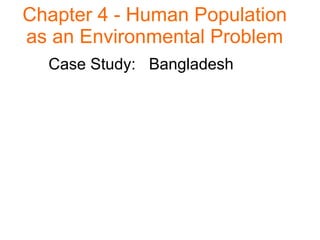
Ch 4 ppt
- 1. Chapter 4 - Human Population as an Environmental Problem Case Study: Bangladesh
- 4. Relative Impact Avg. American vs. Others
- 5. Developing countries represent a larger and larger share of world population because of higher populations and higher birth rates .
- 7. For most of human history, population grew slowly, but in modern times it has suddenly "exploded." agriculture Industrial rev.
- 8. © 2003 John Wiley and Sons Publishers Fig 5.4 United States population 1790 to 2000. Tapering off? 1 million people added to the world every 4 days!!
- 9. Number of Women 15 to 49 Billions Source: United Nations, World Population Prospects: The 2004 Revision (medium scenario), 2005. Women of Childbearing Age
- 11. © 2003 John Wiley and Sons Publishers Doubling time changes rapidly with the population growth rate . Takes less time to double if high growth rate
- 13. Population Doubling Time Examples:
- 14. © 2003 John Wiley and Sons Publishers Logistic growth curve .
- 17. Fig. 6.15 This figure shows population profiles for developed and developing countries, projected to the year 2025 . Improved living conditions education
- 19. © 2003 John Wiley and Sons Publishers Fig 5.9 Causes of mortality in industrializing, developing and industrialized nations .
- 28. The number of women in their childbearing years has increased since the 1950s and is projected to continue to increase to 2050. The number of children per woman has declined since the 1950s and is projected to continue to decline. Even though women have on average fewer children than their mothers, the absolute number of babies being born continues to increase because of the increases in the total number of women of childbearing age.
- 29. © 2003 John Wiley and Sons Publishers Constant TFR Slow fertility reduction Rapid fertility reduction
- 30. Total fertility rate decreases as income increases. © 2003 John Wiley and Sons Publishers
Notes de l'éditeur
- 123.4 million people Annual growth of 1.8% (2.2 mill. Annually) one of the poorest countries..less than 1/2 have safe drinking water Life span = 59 years Low lying - mostly uninhabitable except there are so many people = no choice People barely survive, why would they care about env. measures
- Doubling time changes quickly as growth rate changes Belgium, Aust, Germ, GB = 700 years China = 50 years Continued exp growth would eventually deplete all the matter in the universe (pg 84)
- Ex: in the US - the inflection point was assumed in the 1930’s projected pop was then estimated at 200 million today we have 260 million
- Many nations are struggling to shift from #2to #3 To achieve #3 parents must believe a small family is to their benefit Even an industrialized country @ stage 3 could cycle through all the stages again if health improvements increase for aging and chronic diseases
- Crude death rate in switz = 9 per 1000 in sierra leone = 30 per 1000
- Discuss predator / prey population curves Need to agree on an accepted standard of living to do a global projection
- Short term: ex = wars, crop failures, drought, nuclear war, epidemics Int term: ex = desertification, pollution, toxic waste dumping, decrease in fuel or other natural resources Long term: soil erosion, ground water depletion or contamination, climate change, ozone depletion Some say that we have already exceeded our carrying capacity Some argue that we will always come up with new technology to increase our productivity, hence our carrying capacity
- Baby boom: After www2 1995 = bulge in 35 - 45 year age group Secondary bulge as these boomers have kids Baby boom bulge is moving on through the age structure At each stage different pressures were put n social and economic resources crowded elementary schools as we age- greater pressure on social services, medicare….
- Today trf = 2 during the baby boom it was 3.8 this is a decline in population over time Lag effect is due to previous high fertility rate so lots of young childbearing age women are having kids (see fig 5.11 on pg 90) TFR declines as income increases (fig 5.10 pg 90)
- It’s estimated that if Bangladesh adopted Sri Lanka’s marriage pattern families would have 2.2 fewer kids Older marriage age = 40 - 50% drop in fertility to achieve ) populations growth for many countries China has laws about this : marriage = age 20 for females and 22 for males fertility rate = 5.7 in 1972 to 2.1 in 1985 goal = 0 pop growth by 2000 has this been achieved?
- Family planning = abstinence, sterilization, the pill, contraceptive devices Abortion: 45 - 60 million annually, abortion rate = # per 1000 women (in US = 23) abortion ratio = # per live births (in US = 335)
- Hard to generalize for different nations. Different beliefs… India inn 1952 was first country with formal pop policy Type of policy for diff. Nations differs; some give out only info some also supply the materials needed